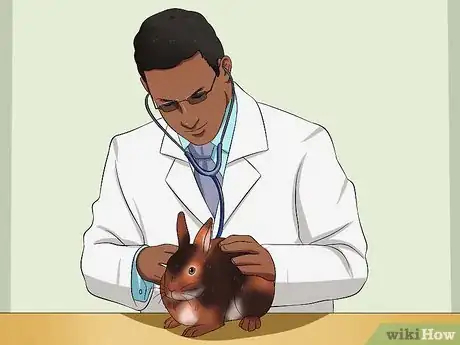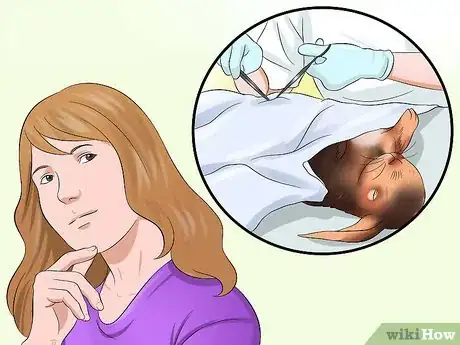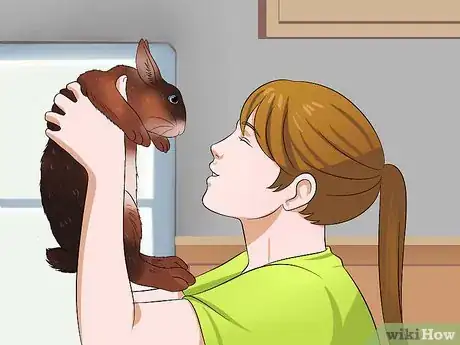This article was co-authored by Pippa Elliott, MRCVS. Dr. Elliott, BVMS, MRCVS is a veterinarian with over 30 years of experience in veterinary surgery and companion animal practice. She graduated from the University of Glasgow in 1987 with a degree in veterinary medicine and surgery. She has worked at the same animal clinic in her hometown for over 20 years.
There are 8 references cited in this article, which can be found at the bottom of the page.
wikiHow marks an article as reader-approved once it receives enough positive feedback. In this case, several readers have written to tell us that this article was helpful to them, earning it our reader-approved status.
This article has been viewed 42,715 times.
Rex rabbits are coveted for their plush, short fur, which sets them apart from other rabbit breeds. Rex rabbits come in many different colors, such as pure white, amber, chocolate, lilac, and black.[1] If you have a Rex rabbit, then you will need to take good care of your rabbit’s health, housing, and nutritional needs.
Steps
Protecting Your Rex Rabbit’s Health
-
1Take your Rex rabbit to see a veterinarian. Try to find a veterinarian who has an interest in rabbits and who is comfortable providing veterinary care for rabbits as well. You might need to seek out an exotics veterinarian or at least find a veterinarian who has done some ongoing professional development on rabbits. Take your Rex rabbit for annual checkups and watch for any signs of a problem. If your Rex rabbit seems like he is sick, then take him to see a veterinarian right away. Signs that your Rex might be sick include:
- losing lots of fur
- not going to the bathroom
- not using back legs or not hopping
- producing dark red urine or no urine
- seeming extra tired and not moving or reacting normally
- having loose stools
- having a fever of 105 degrees Fahrenheit or higher
- having runny eyes and/or nose
- drooling (wet chin)
-
2Get your Rex spayed or neutered. Spaying and neutering your rabbit helps to prevent unwanted litters and it can also protect your rabbit’s health in certain ways. If you do not plan on breeding your Rex rabbit, then get your rabbit spayed or neutered.
- Not spaying and neutering predisposes your rabbit to hormonal behaviors, like urine spraying, food guarding, and fighting. Female rabbits also have a higher risk of uterine cancer if they are not spayed.[2]
Advertisement -
3Play with your Rex rabbit. Your Rex will need to get plenty of exercise to stay healthy. Try to allow your Rex at least two hours of exercise outside of his cage every day. When you exercise your Rex, make sure that you:[3]
- Do not let your rabbit play outside. Your rabbit will be in danger from predators and parasites if you let her play outside. Inside of your home is the safest place for your Rex rabbit.
- Confine your Rex to one or two rooms. You can use baby gates to keep your rabbit from getting lost in your house and to make it easier to supervise her as well.
-
4Stop your Rex from chewing on off-limits items. A Rex rabbit will chew on almost anything, including door edges, wall trim, chairs, table legs, area rugs, loose carpeting, or loose wallpaper.[4] That is why it is so important to monitor your rabbit closely when she is playing outside of her cage.
- If you notice your Rex rabbit chewing on something that she shouldn’t, don’t get mad or punish your rabbit. Just gently pick up her up, place her somewhere else, and then give her something else to chew on, such as a cardboard box, cotton cloth, or an apple slice.
-
5Cover up electrical cords. Your Rex rabbit will also chew on electrical cords, which can harm her and damage your electronics. Cover up electrical cords with hard plastic tubing or some spiral wrap. If you don’t have something to cover your electrical cords, then just lift them off of the ground so your rabbit can’t access them.[5]
-
6Brush your Rex rabbit as needed. Your Rex rabbit will need a quick brushing about once per week to keep him from shedding as much and to keep his fur soft. Run a natural bristle brush or comb over your rabbit’s fur about once per week.[6]
- Don’t let your Rex rabbit get wet and do not bathe him. Rabbits are not fond of water and they can also develop hypothermia if they get wet.
Housing Your Rex Rabbit
-
1Keep your Rex rabbit indoors. Keeping your Rex rabbit outside is a bad idea because rabbits are prone to attacks from predators, overheating, hypothermia, and loneliness. Your Rex rabbit will be at a higher risk of an early death if you keep her outside instead of inside your home.
- Even if your Rex rabbit is safe inside of her cage, rabbits frighten easily and she may have a heart attack from just seeing a predator.
- Your Rex rabbit may also develop some antisocial behavior if you keep her outside. For example, she may start to fear people or become aggressive.
-
2Choose your Rex rabbit’s cage. There are lots of different rabbit enclosures to choose from. You can keep your Rex in a single room of your home that has been rabbit-proofed, house your rabbit in a puppy playpen, get a rabbit condo, or select a standard cage.[7] When selecting an enclosure for your rabbit, make sure that you consider:
- Size. Your rabbit’s cage should be four or five feet long and about two feet wide. The cage should be high enough for your Rex rabbit to stand up on her hind legs without her ears touching the top of the cage.[8]
- Floor. Avoid wire bottom cages because they can hurt your Rex rabbit’s feet. Try to find a solid metal bottom cage. If you cannot find a solid metal bottom cage, then you can cover the bottom of the cage in a piece of plywood that covers the entire floor of the cage.
- Bedding. Cover the floor of your Rex rabbit’s cage with at least two to three inches of bedding. You can use straw, paper pulp, or shredded cardboard.[9] Do not use cedar or pine shavings as your Rex rabbit’s bedding or as litter. Your Rex rabbit may develop respiratory and liver problems from these materials.
-
3Provide a hiding spot for your Rex rabbit. Rabbits like to hide to when they feel scared or stressed, so it is important to provide your Rex with a hiding place. A cardboard box or a wooden box that has a hole cut out of it makes a good hiding spot.[10]
- Provide a hiding spot for each rabbit that you have, otherwise they may fight over the spot.
-
4Place a litter box in your rabbit’s cage. Rabbits will use a litter box if one is provided for them. Put a small litter box in one corner of your rabbit’s enclosure and fill it with some newspaper and hay. Make sure that you change the litter box every day to prevent it from smelling.[11]
- Pay attention to where your rabbit likes to go potty and then place the litter box in that corner.
- Keep a litter box or two in your house so that your rabbit will have somewhere to go when she is playing outside of her cage.
Feeding Your Rabbit
-
1Feed your rabbit lots of hay. Hay is an ideal food for Rex rabbits because it provides nutrition and it also wears down your Rex rabbit’s teeth, which are always growing.[12] Make sure that your Rex rabbit has a large supply of fresh hay at all times.
- Refill your Rex rabbit’s hay at least once per day.
- Timothy hay is a good variety for your Rex.
- Try stuffing an empty paper towel roll or a cardboard box with hay for your Rex rabbit.
-
2Give your Rex some rabbit kibble. Rabbit kibble is a nice nutritional supplement for your rex, but you do not need to give him a lot of it. You can give your Rex about ¼ cup of kibble every day unless your veterinarian says to do otherwise. Make sure that you get the plain kibble and not the mixed kind because some rabbits will pick out the tastiest parts and leave the more nutritious ones behind.
- An overweight rabbit may only need 1/8 of a cup of kibble. If you your rabbit is not gaining weight properly, then he may need more than 1/8 of a cup. Ask your veterinarian if you are not sure how much kibble to give your rabbit.[13]
-
3Offer your Rex some veggies and fruits. Rex rabbits enjoy munching on dark leafy greens, carrots, and some fruits. Try to give your Rex rabbit a few leaves of dark leafy greens each day as well as something crunchy, like carrot slices or apple slices. Some healthy veggie and fruit treats for your rabbit include:[14]
- arugula
- broccoli stems
- collard greens
- kale
- bok choy
- carrot slices
- apple slices
- banana slices
-
4Keep your Rex hydrated. Rex rabbits need plenty of fresh, clean water. Although Rex rabbits enjoy drinking out of a ceramic dish, these can tip over and make a mess in the cage. If you do go with a dish, make sure that it is heavy and check it often. Another option is to use a sipper bottle for your rabbit’s water. Sipper bottles will not tip and your rabbit will not be able to kick hay or feces into the water either.
- Refill your rabbit’s water often and clean the dish or bottle out daily.[15]
-
5Feed certain foods to your Rex only in small amounts. Some foods can give your Rex rabbit gas, bloating or diarrhea, so feed them to her sparingly. These foods to give in moderation include:[16]
- broccoli
- cabbage
- cauliflower
- brussel sprouts
- spinach
Warnings
- Never pick up your Rex rabbit (or any rabbit) by the ears or with your hands around its chest only. Holding your Rex this way will cause pain and stress. It also offers no support for the rabbit’s bottom and the rabbit may hurt himself as a result. Try holding your rabbit like a football.⧼thumbs_response⧽
References
- ↑ http://nationalrexrc.org/
- ↑ http://www.spca.org/page.aspx?pid=430
- ↑ https://www.animalhumanesociety.org/adoption/rabbit-care
- ↑ http://rabbit.org/faq-rabbit-proofing/
- ↑ http://rabbit.org/faq-rabbit-proofing/
- ↑ http://rabbit.org/faq-grooming/
- ↑ http://myhouserabbit.com/rabbit-care/housing-your-pet-rabbit-indoors/
- ↑ http://www.therabbithouse.com/indoor/
- ↑ http://www.bunnyhugga.com/a-to-z/housing/rabbit-bedding.html
About This Article
To care for a Rex rabbit, keep it in a puppy playpen, or a cage with a solid metal bottom that’s about 5 feet long and 2 feet wide. Additionally, provide a hiding spot, like a cardboard or wooden box, for it to retreat to when it’s feeling scared. In order to feed your rabbit, give it lots of hay, some rabbit kibble, and a variety of fruits and vegetables. You should also cover any electrical cords throughout your home since Rex rabbits will chew on almost anything. For more tips from our Veterinary co-author, including how to groom your Rex rabbit, keep reading!













































































